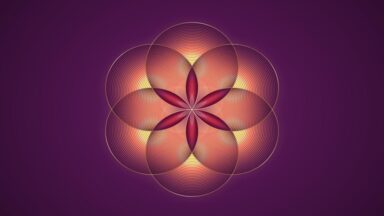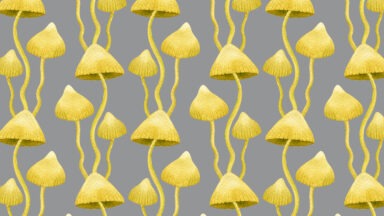Sri Yantra: The Sacred Symbol That Channels Universal Energy

The Sri Yantra, also known as Shri Yantra or Shree Yantra, is an ancient spiritual symbol that has been used for centuries as a tool for meditation and inner transformation. Its precise and harmonious design is filled with meaning and is considered a bridge between the human and the divine.
In this article, we explore what the Sri Yantra is, its origins, what its spiritual power entails, and how it can help elevate your consciousness.
Table of Contents
- What Is a Yantra?
- What Is the Sri Yantra and What Does It Represent Spiritually?
- Symbolic Structure: Triangles, Lotus, and the Central Bindu
- Origin and Traditional Use of the Shree Yantra in Vedic Culture
- The Sri Yantra as a Key Symbol of Sacred Geometry
- How to Use the Shri Yantra in Spiritual Practice
- Benefits of Working with the Sri Yantra
- Differences Between the Sri Yantra and Other Sacred Diagrams
- The Sri Yantra as a Portal for Connection with Universal Consciousness
What Is a Yantra?
The word yantra comes from the Sanskrit roots yam (to control) and tra (tool or instrument). A yantra is a sacred geometric diagram used in Hindu and Buddhist tantric traditions for meditation, rituals, and spiritual development. These symmetrical patterns—made up of triangles, circles, lotus petals, and squares—represent cosmic forces and specific deities.
Yantras are considered energetic tools to focus the mind, balance internal energies, and connect with the divine. While the Sri Yantra is the most well-known, other yantras like the Shiva Yantra (for transformation), Vishnu Yantra (for protection and abundance), and Chinnamasta Yantra (for inner power and clearing negativity) are also widely used in spiritual practice. Each yantra is uniquely designed to support the practitioner’s path toward clarity, unity, and spiritual awakening.
What Is the Sri Yantra and What Does It Represent Spiritually?
The Sri Yantra is a sacred diagram composed of interlocking triangles forming a complex and perfectly symmetrical pattern. In the Vedic tradition, it is known as “the king of the yantras” due to its spiritual potency and for representing a complete vision of the universe and human consciousness. Its structure is not merely decorative: each shape serves a purpose and transmits a specific energy.
On a spiritual level, the Sri Yantra reflects the union of masculine (Shiva) and feminine (Shakti) energies, symbolizing the soul’s return journey to the divine source. Every part of the design represents an aspect of existence, from the material to the transcendent. Gazing at or meditating with the Sri Yantra helps align the various levels of the self, activate energy flow, and access higher states of awareness.
Symbolic Structure: Triangles, Lotus, and the Central Bindu
At the center of the Sri Yantra are nine interlocking triangles that form 43 smaller ones. Each triangle represents a different aspect of existence and consciousness.
- The four upward triangles represent masculine energy, or Shiva. They point toward the heavens and reflect strength, awareness, and expansion.
- The five downward triangles represent feminine energy, or Shakti. They point toward the earth and express creativity, intuition, and nurturing.
Together, the upward and downward triangles create perfect harmony, showing how divine energies unite to form the creative flow of the universe.
The Lotus Petals: Spiritual Awakening
Encircling the triangles are two rings of lotus petals, which represent purity and spiritual growth. The lotus flower is a symbol of awakening, reminding us that even from the depths of the material world, the soul can rise toward divine wisdom.
- The 16 outer petals connect to the senses and the natural elements.
- The 8 inner petals represent inner qualities such as compassion, focus, and balance.
The Circles: Flow of Universal Energy
Beyond the lotus are three circles, which represent the cycles of life and the continuous movement of universal energy. They remind us that all things in creation are connected and constantly evolving.
The Outer Square: Sacred Foundation
Surrounding the circles is a square with four gates, known as the bhupura. It represents the element of Earth and acts as a protective boundary. The four openings symbolize the directions of the world and the pathways for divine energy to enter and flow freely.
The Central Point (Bindu): The Source of Creation
At the very center of the Sri Yantra lies the bindu, or central point. It represents the stillness of pure consciousness and the origin of all creation. The bindu is where masculine and feminine energies meet, where all duality dissolves, and unity is experienced. Meditating on the bindu helps quiet the mind, open the heart, and create a deep sense of connection with the universe.
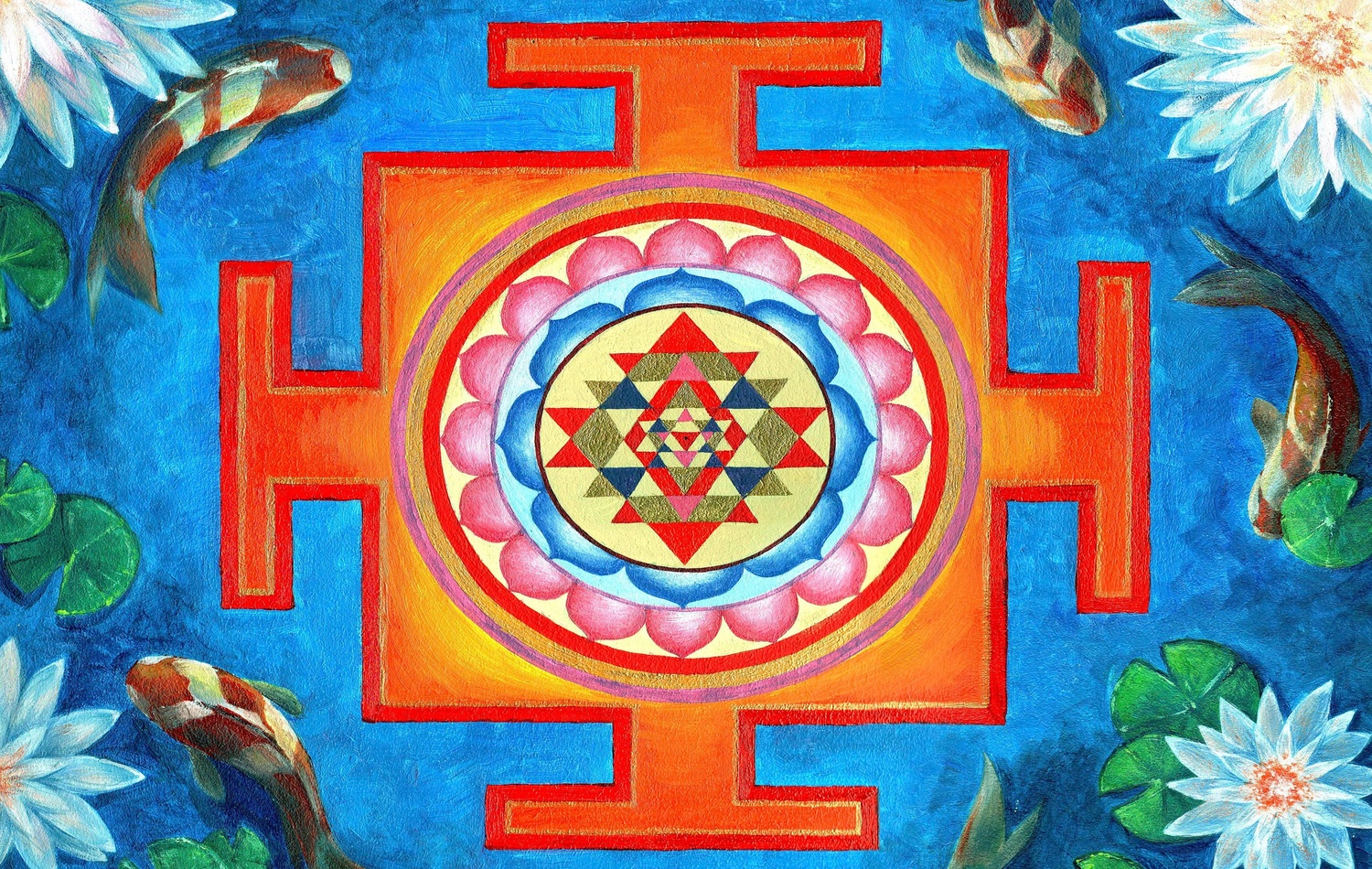
Origin and Traditional Use of the Shree Yantra in Vedic Culture
The origin of the Sri Yantra can be traced back to the ancient Vedic texts of India, where this symbol was described as a direct connection tool to the divine. For centuries, it has been used in devotional practices, tantric rituals, and paths of deep meditation. Within the spiritual tradition known as Sri Vidya, the Sri Yantra represents the geometric form of the goddess Tripura Sundarī, a manifestation of the universal feminine energy.
In Vedic culture, this symbol is not only contemplated but is also activated through mantras, visualizations, and specific ceremonies. Traditional practitioners would draw it with great precision on natural surfaces, carve it in metal, or create it with ephemeral materials like flowers and rice during rituals. It was considered a channel to invoke cosmic energy, harmonize the environment, and foster spiritual realization.
Beyond its ritual use, the Sri Yantra has also been applied in Vastu Shastra, the Vedic system of spatial design and harmonization. When placed in the home or spiritual practice spaces, the symbol balances the energies of the surroundings and protects against negative energy. Its use, both external and internal, reflects a deep understanding of how the universe operates through subtle and ordered patterns.
The Sri Yantra as a Key Symbol of Sacred Geometry
The Sri Yantra is one of the most complex and sacred diagrams within Sacred Geometry. Its harmonious structure is based on exact proportions that reflect the hidden order of the universe. Every triangle, circle, and line represents a specific frequency of energy, and its arrangement is not arbitrary, but the result of ancient knowledge about how consciousness manifests in the material realm.
In Sacred Geometry: Spiritual Science, Robert J. Gilbert, Ph.D., explains how symbols like the Sri Yantra embody universal principles that connect the human body, nature, and the cosmos. Throughout the episodes, these geometric patterns are shown to function as tools to awaken consciousness, balance vital energy, and reconnect with the creative intelligence of the universe.

How to Use the Shri Yantra in Spiritual Practice
The Sri Yantra can be incorporated into various spiritual practices to support concentration, energy healing, and connection with higher states of consciousness. Its conscious use, accompanied by clear intention and respect, allows its sacred geometry to serve as a channel for inner alignment and spiritual expansion.
- Meditative gazing: Placing the Sri Yantra in front of you and softly fixing your gaze on its center naturally calms the mind. This practice facilitates a deep and sustained meditative state.
- Guided visualization: Visualizing the Sri Yantra while engaging in conscious breathing activates the subtle energetic field of the body. This technique raises vibration and enhances inner clarity.
- Placement in space: Positioning the Sri Yantra on an altar, in a meditation space, or in a workspace generates an atmosphere of harmony and protection. Its presence acts as a stabilizer of environmental energies.
- Chanting mantras: Reciting mantras such as “Om” in front of the Sri Yantra enhances its vibrational capacity. The sound interacts with the symbol’s geometry and activates its energetic qualities.
- Intention and manifestation: Using the Sri Yantra as a support to focus intentions amplifies the power of conscious thought. This practice is ideal for manifestation rituals or spiritual focus work.
Benefits of Working with the Sri Yantra
Working consistently with the Sri Yantra can bring about deep transformation on the physical, mental, and spiritual levels. Its geometry functions as an energetic map that guides the practitioner toward inner harmony, clarity, and connection with the universal order.
In Vedic tradition, the Sri Yantra, also known as the Sri Chakra or Shri Chakra, is revered as a magnet for prosperity and success, harmonizing universal energy to attract both spiritual fulfillment and material abundance. Through this balance, the Sri Yantra supports the integration of inner peace and outer well-being.
- Energy balance: Helps align the body’s energy centers. Supports emotional stability and mental clarity.
- Concentration and focus: Enhances attention span during meditation. Its geometric design facilitates mental stillness.
- Spiritual connection: Opens the door to experiences of unity and expanded consciousness. Fosters connection with higher planes.
- Environmental protection: Cleanses and stabilizes the energy of the space where it is placed. Brings a sense of calm and safety.
- Conscious manifestation: Amplifies the power of intention and positive energy, helping align one’s thoughts with desired outcomes and inviting both spiritual and material prosperity.
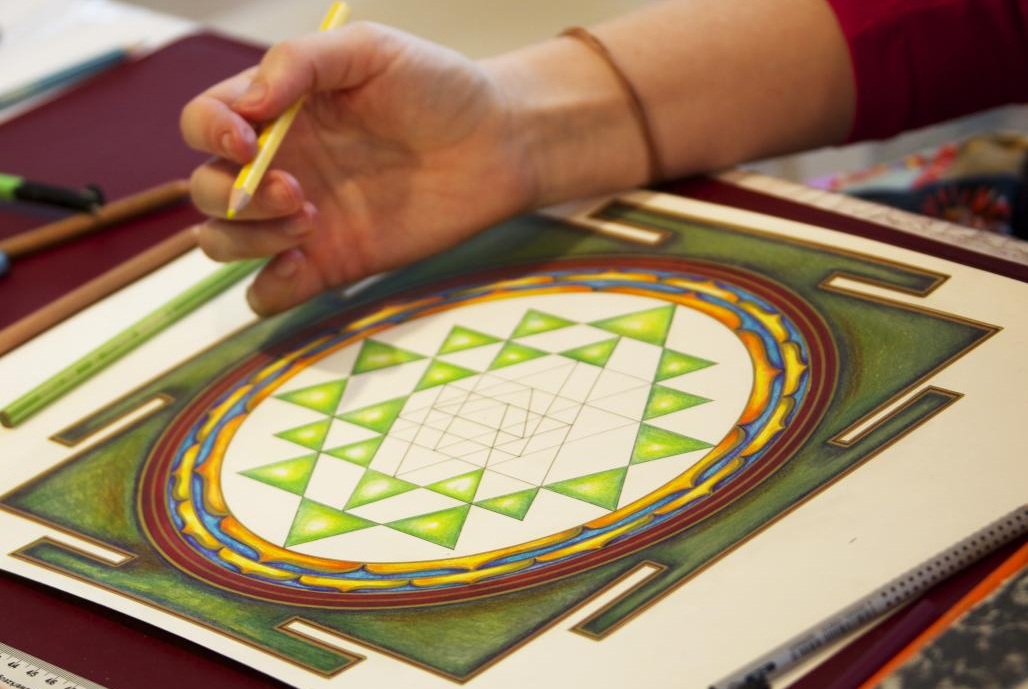
Differences Between the Sri Yantra and Other Sacred Diagrams
The Sri Yantra stands apart from other sacred geometry symbols due to its level of complexity, symbolic depth, and specific spiritual function. Unlike other diagrams, which may represent universal energy structures or patterns of creation, the Sri Yantra embodies a complete spiritual journey, serving both as a cosmic map and a transformative meditation tool.
- Flower of Life: Represents the matrix of creation and the interconnectedness of all existence. The Sri Yantra, by contrast, guides toward union with supreme consciousness.
- Mandalas: In Hinduism and Buddhism, mandalas are sacred circular designs that symbolize the universe, balance, and divine harmony. They’re often used in meditation and ritual to calm the mind and deepen spiritual awareness. The Sri Yantra is considered a special type of mandala, known in Hindu Tantra for its precise geometry made of nine interlocking triangles that represent the union of Shiva and Shakti and the creation of all existence.
- Metatron’s Cube: Displays the fundamental geometric forms of the universe and its energetic structure. The Sri Yantra activates the internal process of spiritual ascension.
- Merkaba: Functions as a light vehicle to access other dimensions. The Sri Yantra acts as a portal for integrating all forces of being.
- Seed of Life: Represents the seven days of creation and the beginning of every cycle. The Sri Yantra encompasses all stages, from origin to divine fulfillment.
- Star of David: Symbolizes duality and the harmony between masculine and feminine. In the Sri Yantra, that union gives rise to the manifestation of the entire universe.
The Sri Yantra as a Portal for Connection with Universal Consciousness
The Sri Yantra is more than a geometric pattern. It is a doorway to higher awareness and a reflection of the harmony that exists in all of creation. Its design follows the Golden Ratio, the same proportion found throughout nature, symbolizing balance between the human and the divine.
Each triangle, circle, and lotus petal carries energy that can calm the mind and clear negativity. Meditating on the Sri Yantra helps restore peace and balance within, creating space for clarity and spiritual connection.
At its center lies the bindu, the still point where all creation begins. Focusing on this center opens the heart to unity, reminding us that divine energy is not separate from us but lives within everything.
Discover the Seed of Life and Its Spiritual Meaning
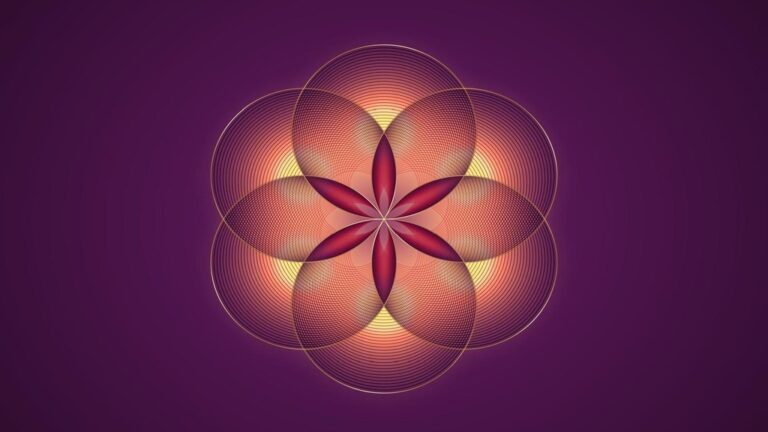
The Seed of Life is a geometric figure composed of seven overlapping circles that form a symmetrical pattern. This symbol, present in ancient spiritual traditions, represents the foundation of creation and the link between geometry and universal consciousness. In this article, we explore the meaning of the Seed of Life, its connection to Sacred Geometry, and how to apply it in spiritual practice.
Table of Contents
- What Is The Seed Of Life?
- Spiritual Meaning Of The Seed Of Life
- How To Use The Seed Of Life In Spiritual Practice
- The Seed Of Life In Sacred Geometry
- History And Evolution Of The Seed Of Life
What Is The Seed Of Life?
The Seed of Life is a symbol of Sacred Geometry made up of seven circles arranged in a hexagonal structure. It originates from a single central circle, to which six equally sized circles are added, creating a harmonious and balanced pattern. This figure is considered the base for more complex geometric structures such as the Flower of Life and Metatron’s Cube.
Throughout history, various cultures have used the Seed of Life as a symbol of creation and the expansion of consciousness. It appears in temples, manuscripts, and sacred art in civilizations such as the Egyptian, Indian, and Mesopotamian. Its structure reflects the mathematical principles that govern nature—from crystal formation to the arrangement of petals in flowers.
In the series Sacred Geometry: Spiritual Science, available on Gaia, it is explored how these geometric patterns influence reality and the evolution of consciousness. Through the analysis of sacred figures, the series reveals the profound meaning of Sacred Geometry and its application in everyday life.
Spiritual Meaning Of The Seed Of Life
The Seed of Life is a symbol that represents the origin of existence and the interconnection of all things in the universe. Its geometric structure reflects the balance and harmony present in nature—from atoms to galaxies. In many traditions, it is considered a sacred map of creation that contains the fundamental patterns of reality. Studying and contemplating it helps understand the relationship between human consciousness and the cosmic order.
Energetically, the Seed of Life is associated with the expansion of consciousness and spiritual awakening. Its design is believed to activate the energy flow in the body and facilitate connection with higher levels of perception. In meditation, it is used to center the mind and harmonize emotional states, promoting inner peace. Many people use it as a tool for protection and balance on their spiritual path.
How To Use The Seed Of Life In Spiritual Practice
Incorporating the Seed of Life into spiritual practice can help strengthen the connection with creative energy and universal balance. Its geometric design acts as a channel for harmonization, protection, and personal development. Below are some ways to use it in daily life:
- Visual meditation: Observing the Seed of Life while meditating helps calm the mind and increase focus. Its geometric structure facilitates connection with higher states of consciousness and energetic balance.
- Energetic protection: Wearing this symbol as an amulet or placing images of it in personal spaces is associated with cleansing the auric field. Its vibration is believed to repel negative energies and bring emotional stability.
- Chakra activation: Placing the Seed of Life over the body’s energy centers can improve energy flow. It is used in practices such as Reiki or vibrational therapy to harmonize the energetic system.
- Mandalas creation: Drawing or coloring this geometric pattern is a therapeutic practice that stimulates creativity and introspection. This activity helps relax the mind and connect with the energy of the universe.
- Charging water and objects: Placing the Seed of Life near a container of water or on top of crystals is said to enhance their vibration. Many people use it to energize spaces and strengthen intention in spiritual rituals.
The Seed Of Life In Sacred Geometry
The Seed of Life is an essential pattern within Sacred Geometry, a discipline that studies the forms and proportions that structure reality. Its design is based on mathematical and geometric principles that reflect the order of the universe. It is considered a primordial symbol that represents the process of creation—from unity to the manifestation of matter.
This pattern is the foundation of more complex structures, such as the Flower of Life and Metatron’s Cube, used in various spiritual traditions. Its presence in ancient civilizations demonstrates its importance in esoteric knowledge and its relationship with universal energy. Exploring its meaning allows us to understand the connection between human consciousness and the architecture of the cosmos.
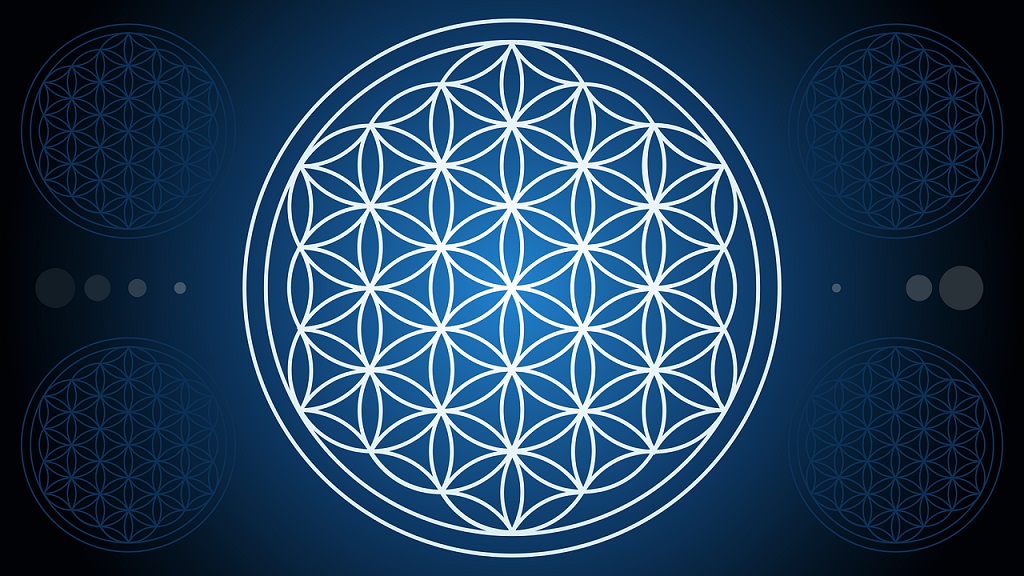
The Seed of Life is the core of the Flower of Life, a broader geometric pattern composed of multiple interconnected circles. While the Seed represents the first steps of creation, the Flower symbolizes the expansion of the universe and the interconnection of all existence. Its structure has been found in temples, manuscripts, and sacred art across various cultures around the world.
Within Sacred Geometry, the Flower of Life is considered a symbol of perfection and cosmic unity. It is said to contain the fundamental codes of reality, such as the Platonic Solids and the Golden Ratio. Studying and contemplating it allows access to profound knowledge about the nature of the universe and spiritual evolution.
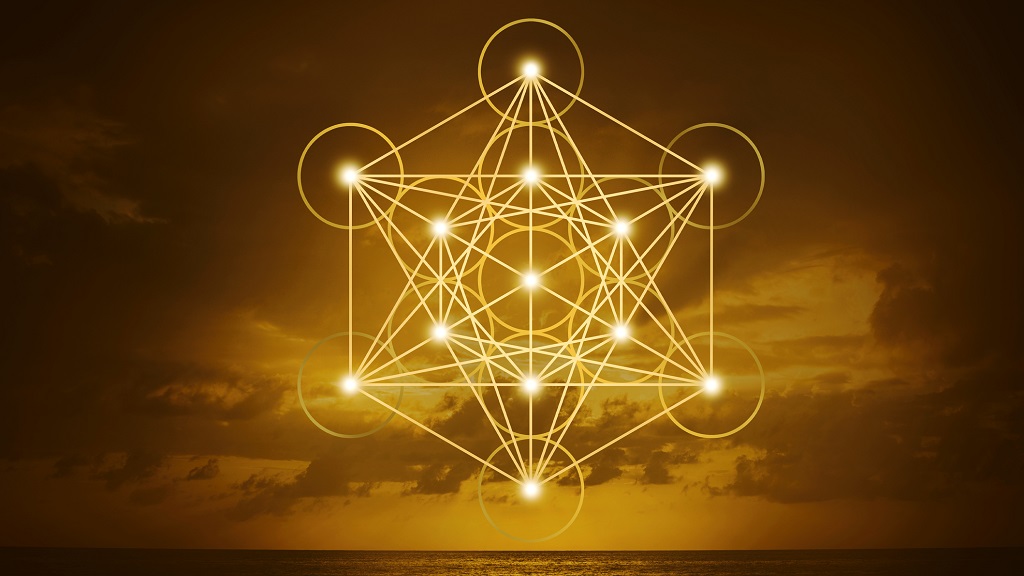
Metatron’s Cube is a geometric figure derived from the Flower of Life, in which all the Platonic Solids can be found. Its connection with the Seed of Life lies in their shared origin within Sacred Geometry, where both represent different stages of the manifestation of reality. It is believed that Metatron’s Cube acts as a bridge between the physical and the spiritual worlds, being used in meditations and energetic practices.
This symbol is known for its ability to harmonize and balance energies, functioning as a tool for protection and spiritual activation. In many traditions, it is used to cleanse spaces, raise vibration, and access higher states of consciousness. Its relationship with the Seed of Life demonstrates how geometric patterns reflect universal principles of order and creation.
History And Evolution Of The Seed Of Life
The origin of the Seed of Life dates back to ancient civilizations that used Sacred Geometry in their architecture, art, and spiritual traditions. Examples of this symbol have been found in Egyptian temples, Hebrew manuscripts, and sacred constructions in India. Its presence across different cultures indicates a shared understanding of the universe’s fundamental patterns and their relationship with spirituality.
During the Renaissance, scholars such as Leonardo da Vinci studied Sacred Geometry and its applications in art and science. Da Vinci analyzed the Flower of Life and its internal forms, including the Seed of Life, recognizing its relationship with divine proportion. His work helped rekindle interest in these patterns and their influence on the structure of nature and human design.
Today, the Seed of Life continues to be studied and used in spiritual practices, energy healing, and conscious design. Its application in meditation, healing, and ecological architecture demonstrates its relevance in understanding balance and universal harmony. Its message of unity and creation continues to resonate, connecting people with the mathematical and spiritual essence of the cosmos.



